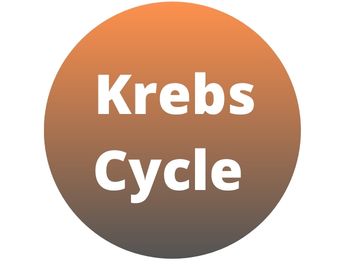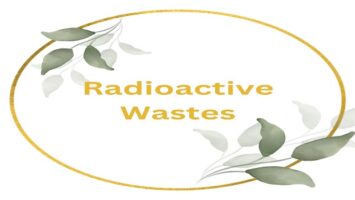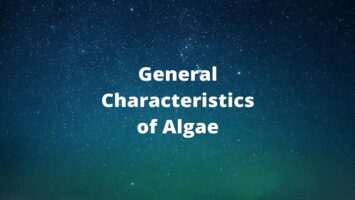Table of Contents
Krebs Cycle:
The respiratory cycle which takes place in mitochondria in the presence of oxygen is known as the Krebs cycle after the name of an English biochemist, Hans A. Krebs, who discovered its various steps in 1937 and received the Nobel Prize in 1953 for this work. This cycle is also known as the citric acid cycle because of the formation of citric acid at the first step. It is also called the tricarboxylic acid cycle (TCA) because many intermediate compounds formed in the cycle have three carboxyl groups.
Site of Occurrence: This cycle is confined to the mitochondria.
Significance: This cycle serves as a common oxidative pathway for carbohydrates, proteins and fats. The end products of glucose and amino acids change to acetyl coenzyme A to enter the Krebs cycle, whereas β-oxidation of fatty acid produces acetyl CoA as the end product. Some intermediates of the TCA cycle are used in synthesising important biomolecules such as glutamate and aspartate.

Krebs Cycle Steps:
Krebs Cycle involves the following steps-
(1) Condensation (Formation of Citric Acid)- Acetyl CoA combines with oxaloacetate in the presence of condensing enzyme citrate synthetase. CoA is released. The product of condensation is citrate which is a tricarboxylic 6-carbon compound.

(2) Isomerisation- Citrate is converted into its isomer isocitrate in a two-step reaction in the presence of iron containing enzyme aconitase.
- Dehydration- A molecule of water is released and citric acid is changed into cis-Aconitate.

- Rehydration- Cis-aconitate combines with a molecule of water and forms isocitrate.

(3) Dehydrogenation I and Decarboxylation I-
- Stage (a)- This is the first oxidation step of the Krebs cycle. In this step, two hydrogen ions (protons) are removed (oxidation) from isocitric acid and oxalosuccinic acid is formed in the presence of the enzyme isocitrate dehydrogenase. Hydrogen ions are received by NAD+ forming NADH + H+.

- Stage (b)- In this step, decarboxylation of oxalosuccinic acid takes place in the presence of enzyme carboxylase and α-ketoglutaric acid (5C) is formed. During this process, CO2 is released.

(4) Dehydrogenation II and Decarboxylation II- This is the second oxidation step of the Krebs cycle. This is a two-stage process-
- Stage (a): In this stage, α-ketoglutaric acid reacts with coenzyme A forming 4-carbon succinyl coenzyme A. The reaction is catalysed by the α-ketoglutaric dehydrogenase enzyme. During the reaction, one molecule of CO2 and a pair of hydrogen ions are released. Hydrogen ions are taken by NAD+ and NADH(+H+) is formed.

- Stage (b): In this stage, succinyl-CoA is acted upon by the enzyme succinyl thiokinase to form succinic acid. The reaction releases sufficient energy to form GTP (guanosine triphosphate) from GDP (guanosine diphosphate).

GTP formed in this reaction gives rise to ATP as follows-
| GTP + ADP —————> GDP + ATP |
(5) Dehydrogenation III- This is the third oxidation step of the Krebs cycle. In this step succinic acid is dehydrogenated to 4-carbon fumaric acid with the action of the enzyme succinic dehydrogenase and 2 hydrogen atoms are released. Hydrogen atoms are received by FAD (flavin adenine dinucleotide) which is reduced to FADH2.

(6) Hydration II- In this step fumaric acid changes to 4-carbon malic acid by the enzyme fumarase.

(8) Dehydrogenation IV- This is the fourth oxidation step of the Krebs cycle in which malic acid is oxidized to oxaloacetic acid in the presence of NAD+ and the enzyme malate dehydrogenase. During the reaction, a pair of hydrogen atoms are released which form NADH(+H+) from NAD+.

Thus oxaloacetic acid is regenerated at the end of the Krebs cycle, which recombines with acetyl coenzyme A to form citric acid for restarting the Krebs cycle.
During one Krebs cycle, complete oxidation of one molecule of Acetyl CoA releases 2 molecules of CO2. In the four oxidation steps of the Krebs cycle, four pairs of hydrogen ions and electrons are removed from the intermediates of the cycle. Of these, three are utilized in the reduction of NAD+ to NADH(+H+) and the fourth in the reduction of FAD to FADH2.
Summary of Krebs Cycle or TCA Cycle:
- Kreb’s cycle is initiated by the introduction of one molecule of acetyl CoA which introduces one acetyl group (2C) in the cycle.
- It utilizes 4 molecules of water at different steps and releases one.
- Liberates 2 molecules of CO2 by the action of enzymes decarboxylases.
- Four pairs of hydrogen atoms are released by enzymes dehydrogenases. Of these three pairs reduce NAD to NADH(+H+) and one goes to FAD forming FADH2.
- NADH and FADH2, the reduced coenzymes, transfer their electrons to the mitochondrial respiratory chain and get reoxidized.
- One GTP molecule is produced.
- Regenerates oxaloacetic acid in first reaction for reuse.
The above account is for one molecule of acetyl coenzyme A. There are 2 acetyl coenzyme A molecules formed from one molecule of glucose by glycolysis and oxidative decarboxylation of pyruvic acid. Thus there are two Krebs cycles for one molecule of glucose which can be represented by the following equation-
| 2 Acetyl coenzyme A + 6NAD+ + 2FAD+ + 2GDP/ADP + 2Pi ——–> 4CO2 + 6NADH(+H+) + 2FADH2 + 2GTP/ATP |
The 6NADH and 2FADH2 provide energy (22 ATP) to the cell in the electron transport chain.
Summary of Products of Glycolysis, Pyruvic Oxidation and Krebs Cycle:
For each glucose molecule that starts oxidation, Krebs cycle turns twice. Thus:
- Glycolysis produces 2NADH2and 2ATP.
- Oxidation of pyruvic acid gives 2CO2 and 2NADH(+H+).
Adding to this the yield of 2 Krebs cycles, we get-
| Glucose + 10NAD+ + 2FAD + 4ADP + 4Pi ———–> 10NADH2 + 2FADH2 + 4ATP + 6CO2 |









Comments (No)